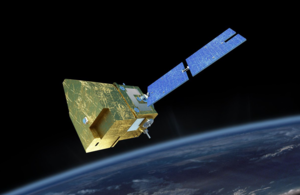MicroCarb
MicroCarb is a joint mission between the UK Space Agency and CNES that will measure sources and sinks of carbon, the principal greenhouse gas driving global warming.

Artist Impression of Microcarb. Credit: CNES.
Understanding the behaviour and dynamics of greenhouse gases in the Earth’s atmosphere, and the processes by which they are produced and absorbed, is a key part of understanding our changing climate.��
MicroCarb is the first European mission intended to characterise greenhouse gas fluxes on Earth’s surface and gauge how much carbon is being absorbed by oceans and forests, the main sinks on the planet.��
Adding to the work of previous CO2 missions, Microcarb will become part of an international greenhouse gas monitoring network of satellites, and collect more precise data on CO2 emissions than ever before. This will improve our understanding and monitoring ability of the natural carbon cycle and emissions from human activity. Microcarb will also monitor international progress towards meeting the to limit global surface warming, and allow us to determine how much carbon is being absorbed by natural processes and how much is being emitted by human activity.��
Microcarb’s city-scan observing capability will map atmospheric CO2 over cities, providing insights for cities to incorporate sustainability into their urban planning.��
Monitoring greenhouse gas data will allow us to anticipate how ecosystems, habitats and societies will react to climate change, and provide insights on how to mitigate and minimise damage.��
On 2 February 2024, it was announced that Microcarb was ready for launch. The completed satellite was delivered by Thales Alenia Space UK (TAS UK) to the French Space Agency, CNES, where it awaits shipment for launch.
Launch is expected no earlier than 2025.��
Instrumentation and measurement
Once launched, Microcarb will orbit at an altitude of 650km, and will repeat its cycle of observation and measurements every 21 days.��
It will carry an infrared spectrometer, which will measure O2 and CO2 concentrations at 4 different spectral bands in sunlight reflected off the Earth: 0.76μm, 1.27μm, 1.6μm and 2μm.��
The infrared spectrometer’s degree of precision will be extremely high. Measurements of CO2 concentrations will be in the order of 1ppm (part per million), with a pixel size of 4.5x9km. The city-scanning observing mode will have a resolution of 2x2km2.��
MicroCarb will also retrieve Solar Induced Fluorescence (SIF), which will provide data about photosynthetic activity and enrich data from CO2 observations about carbon sinks.��
How is the UK involved?
The UK has a range of roles from assembling and testing the satellite, ground segment algorithms to leading UK scientists on the Mission Advisory Group.��
The UK is involved with the Assembly, Integration and Testing of satellite, design and build of key parts, data collection, algorithm development and scientific mission preparation.��
The UK Space Agency invested £13.9 million in the mission, securing the following UK expertise:
The has provided the SI-traceable ground calibration facility, to test its performance pre-launch. Paul Green of NPL has developed algorithms and quality metrics with the MicroCarb team.
is completing the assembly, integration and testing at STFC RAL Space in Harwell, Oxfordshire.��
has designed the pointing and calibration system, enabling MicroCarb to take measurements at specific locations.��
are designing, implementing and quality assuring algorithms and operational processors for several CO2 data products.��
of the and the will translate MicroCarb’s CO2 observations into maps that show carbon absorption and emissions.��
is part of the NCEO team delivering the mission’s Solar Induced Fluorescence retrieval algorithm, based on expertise from the .
Updates to this page
-
Updates and more detail added about the mission, and the page has been restructured.
-
Updated information.
-
First published.